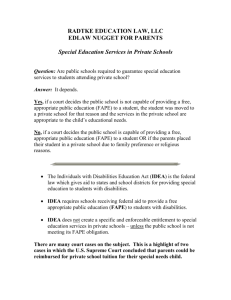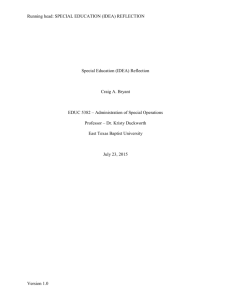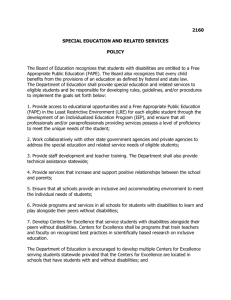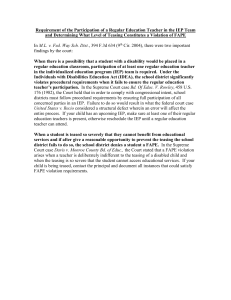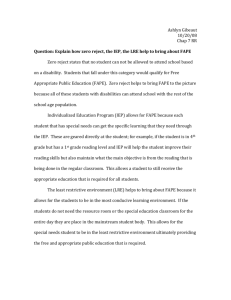Some Benefit,* or Something Else? - Seattle University School of Law
advertisement
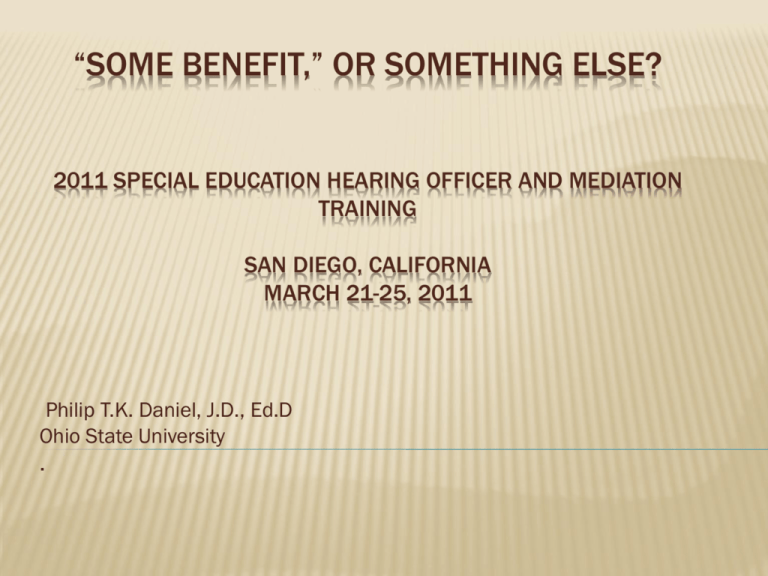
“SOME BENEFIT,” OR SOMETHING ELSE? 2011 SPECIAL EDUCATION HEARING OFFICER AND MEDIATION TRAINING SAN DIEGO, CALIFORNIA MARCH 21-25, 2011 Philip T.K. Daniel, J.D., Ed.D Ohio State University . NCLB/IDEA LINK? Given the design of NCLB should the FAPE provisions of IDEA be revised? NCLB specifically protects students with special needs regarding assessments, needs, & achievement. Does this presage a movement beyond “some benefit”? 2 FREE APPROPRIATE PUBLIC EDUCATION FAPE’s statutory definition is substantively the same as it was in 1975. FAPE means special education and related services that: (A) have been provided at public expense, under public supervision and direction, and without charge; (B) meet the standards of the State educational agency; (C) include an appropriate preschool, elementary school, or secondary school education in the State involved; and (D) are provided in conformity with the individualized education program required under section 1414(d) of this title. 20 U.S.C. § 1401(9) (2010). 3 ROWLEY DECISION IDEA’s cryptic definition of FAPE resulted in the Supreme Court’s seminal case, Rowley, that has provided an enduring interpretation of FAPE. Legal Rules: Congress sought primarily to make public education available to children with disabilities. Congress did not impose upon the States any greater substantive educational standard than would be necessary to make such access meaningful. The Act opens the door to public education, but does not guarantee any particular level of education once Inside. Act does not require school districts to maximize potential of children with disabilities. 4 ROWLEY DECISION Legal Rules: “Congress sought to … identify… evaluate … & provide … access to a free appropriate public education.” “We therefore conclude that the ‘basic floor of opportunity’ provided by the Act consists of access to specialized instruction and related services which are individually designed to provide educational benefit to the handicapped child.” “Insofar as a State is required to provide a handicapped child with a ‘free appropriate public education,’ we hold that it satisfies this requirement by providing personalized instruction with sufficient support services to permit the child to benefit educationally from that instruction.” 5 CHEVROLET STANDARD OF EDUCATION The oft quoted Doe v. Bd. of Educ. of Tullahoma Schools, 9 F.3d 455, 457 (6th Cir. 1993), compares the Rowley standard to two American cars. The Act requires that the Tullahoma schools provide the educational equivalent of a serviceable Chevrolet to every handicapped student. Appellant, however, demands that the Tullahoma school system provide a Cadillac solely for appellant's use. We suspect that the Chevrolet offered to appellant is in fact a much nicer model than that offered to the average Tullahoma student. Be that as it may, we hold that the Board is not required to provide a Cadillac, and that the proposed IEP is reasonably calculated to provide educational benefits to appellant, and is therefore in compliance with the requirements of the IDEA. 6 THIRD CIRCUIT: THE POLK DECISION In 1988, the Third Circuit had occasion to interpret FAPE and apply the Rowley standard. The Rowley Court described the level of benefit conferred by the Act as meaningful. Rowley was an avowedly narrow opinion that relied significantly on the fact that Amy Rowley progressed successfully from grade to grade in a mainstreamed classroom. The Court self-consciously limited its opinion to the facts before it. We hold that the EHA calls for more than a trivial educational benefit. That holding rests on the Act and its legislative history as well as interpretation of Rowley. 7 POLK CONTINUED The EHA's sponsors stressed the importance of teaching skills that would foster personal independence for two reasons. First, they advocated dignity for handicapped children. Second, they stressed the long-term financial savings of early education and assistance for handicapped children. A chief selling point of the Act was that although it is penny dear, it is pound wise-the expensive individualized assistance early in life, geared toward teaching basic life skills and self-sufficiency, eventually redounds to the benefit of the public fiscally as these children grow to become productive citizens 8 POLK CONTINUED “To summarize, in our view, the danger of the district court's formulation is that under its reading of Rowley the conferral of any benefit, no matter how small, could qualify as ‘appropriate education’ under the EHA.” 9 POTENTIAL The Third Circuit also requires that special education must be designed to provide meaningful benefit “gauged in relation to a child’s potential.” T.R. ex rel. N.R. v. Kingwood Township Bd. of Educ., 205 F.3d 572, 577 (3rd Cir. 2000). 10 1997 AMENDMENTS In 1997, Congress made significant changes to IDEA. Specifically, Congress expanded and developed IDEA’s Purpose and put forth a welldeveloped Findings section. 11 20 U.S.C. § 1400(C) (1994). It is the purpose of this chapter to assure that all children with disabilities have available to them, within the time periods specified in section 1412(2)(B) of this title, a free appropriate public education which emphasizes special education and related services designed to meet their unique needs, to assure that the rights of children with disabilities and their parents or guardians are protected, to assist States and localities to provide for the education of all children with disabilities, and to assess and assure the effectiveness of efforts to educate children with disabilities. 20 U.S.C. § 1400(D) (2000). The purpose of the IDEA is to ensure that: [A]ll children with disabilities have available to them a free appropriate public education that emphasizes special education and related services designed to meet their unique needs and prepare them for further education, employment, and independent living; to ensure that the rights of children with disabilities and parents of such children are protected; and to assist States, localities, educational service agencies, and Federal agencies to provide for the education of all children with disabilities; to assist States in the implementation of a statewide, comprehensive, coordinated, multidisciplinary, interagency system of early intervention services for infants and toddlers with disabilities and their families; to ensure that educators and parents have the necessary tools to improve educational results for children with disabilities by supporting system improvement activities; coordinated research and personnel preparation; coordinated technical assistance, dissemination, and support; and technology development and media services; and 1997 AMENDMENTS to assess, and ensure the effectiveness of, efforts to educate children with disabilities. 12 DEPARTMENT OF EDUCATION: A BRIEF EXPLANATION OF THE 1997 AMENDMENTS IDEA '97 - A Major Milestone The IDEA Amendments of 1997 (IDEA '97) represent a major milestone in the education of children with disabilities -- the first major revision to the Act in more than 23 years (since the enactment of P.L. 94-142, the Education of all Handicapped Children Act of 1975). BASIC RIGHTS RETAINED IDEA '97 retains (and strengthens) the basic rights and protections under IDEA -- including: the right to a free appropriate public education (FAPE) for all children with disabilities, including children suspended or expelled from school; and the procedural safeguards rights for these children and their parents. EMPHASIS ON IMPROVING RESULTS IDEA '97 provides a new and heightened emphasis on improving educational results for children with disabilities, including provisions which ensure that these children have meaningful access to the general curriculum through improvements to the IEP, and are included in general education reform efforts related to accountability and high expectations, and that focus on improved teaching and learning. 13 THE SIXTH CIRCUIT RESPONDS Deal v. Hamilton County Bd. of Educ., 392 F.3d 840 (6th Cir. 2004). Following a review of Polk, the Sixth Circuit court heightened FAPE’s educational standard in response to the 1997 amendments. 14 The following excerpt is the Sixth Circuit’s analysis of why Congress’ 1997 amendments to IDEA heightened FAPE’s educational standard. The current version of the IDEA provides further support for such sentiments. Congress explicitly found that shortcomings of the previous act, the Education for all Handicapped Children Act of 1975, included low expectations for disabled children and “an insufficient focus on applying replicable research on proven methods of teaching and learning for children with disabilities.” 20 U.S.C. § 1400(a)(4). Congress has declared that the school personnel who work with disabled children should receive high quality professional development in order to provide such personnel with the skills necessary to “ensure that [all disabled children] have the skills and knowledge necessary to enable them ... to be prepared to lead productive, independent, adult lives, to the maximum extent possible.” 20 U.S.C. § 1400(a)(5)(E). Indeed, one of the stated purposes of the IDEA is “to ensure that all children with disabilities have available to them a free appropriate public education that emphasizes special education and related services designed to meet their unique needs and prepare them for employment and independent living.” 20 U.S.C. § 1400(d)(1)(A) (emphasis added). At the very least, the intent of Congress appears to have been to require a program providing a meaningful educational benefit towards the goal of self-sufficiency, especially where self-sufficiency is a realistic goal for a particular child. Indeed, states providing no more than some educational benefit could not possibly hope to attain the lofty goals proclaimed by Congress. In evaluating whether an educational benefit is meaningful, logic dictates that the benefit “must be gauged in relation to a child's potential.” Polk, 853 F.2d at 185. Only by considering an individual child's capabilities and potentialities may a court determine whether an educational benefit provided to that child allows for meaningful advancement. In conducting this inquiry, courts should heed the congressional admonishment not to set unduly low expectations for disabled children 15 SIXTH CIRCUIT DUE PROCESS HEARING DECISIONS THAT INCORPORATE NEW STANDARD Winton Woods City School Dist. Bd. of Educ., v. Respondents, ODE Case No.: SE-2309-2009 (January 28, 2010). More recently, the Sixth Circuit Court of Appeals has further refined the definition of educational benefit under the IDEA. In Deal v. Hamilton County Board of Education, 392 F.3d 840 (6th Cir., 2004), the Court held that an IEP must provide meaningful educational benefit with the ultimate goal of self-sufficiency if that is a realistic goal for the child. Thus, in order to determine if Student’s IEP in this case provides a FAPE, it must be born in mind that while Petitioner is not obligated to provide education which seeks to maximize Student’s potential, it is obligated to provide education designed to foster Student’s independence to the extent of her abilities. 16 SIXTH CIRCUIT DUE PROCESS HEARING DECISIONS THAT INCORPORATE NEW STANDARD Student v. Forest Hills Local School Dist., ODE Case No.: SE-2262-2009 (October 6, 2009). The District is required to provide to the Student with a Free Appropriate Public Education (FAPE). The Supreme Court has defined ‘Appropriate’ to mean that the IEP must be designed to provide a ‘meaningful educational benefit,’ Rowley, 458 U.s. at 192. This is not done if an IEP affords the opportunity for only ‘trivial advancement.’ An appropriate public education under IDEA is one that is “likely to produce progress, not regression. 17 SIXTH CIRCUIT DUE PROCESS HEARING DECISIONS THAT INCORPORATE NEW STANDARD Student v. Solon City School Dist., ODE Case No.: SLR-2183-2008 (March 16, 2009). A school district meets its obligation to provide a FAPE if it has (a) complied with the procedural requirements of the IDEA, and (b) developed an IEP that is reasonably calculated to provide an educational benefit. Deal v. Hamilton Cty. Bd. of Educ., 392 F.3d 840, 853-54 (6th Cir. 2004). In Deal, the 6th Circuit added the requirement that an IEP must be tailored to confer a ‘meaningful education benefit,’ but upheld the rule, first espoused in Rowley, that school districts are not required to maximize each child’s potential. Id. at 862. If these requirements are met, the state has complied with the obligations imposed by Congress and the courts can require no more. 18 THE NINTH CIRCUIT RESPONDS… MAYBE N.B. v. Hellgate Elementary School District, 541 F.3d 1202 (9th Cir. 2008). Under the 1997 amendments to the IDEA, a school must provide a student with a ‘meaningful benefit’ in order to satisfy the substantive requirements of the IDEA. See Adams v. Oregon, 195 F.3d 1141, 1145 (9th Cir.1999) (applying the “meaningful benefit” test); see also Deal v. Hamilton County Bd. of Educ., 392 F.3d 840, 862 (6th Cir.2004). 19 THE NINTH CIRCUIT RESPONDS… MAYBE Adams v. State of Oregon, 195 F.3d 1141 (9th Cir.1999). “IDEA and case law interpreting the statute do not require potential maximizing services. Instead the law requires only that the IFSP in place be reasonably calculated to confer a meaningful benefit on the child” 20 THE NINTH CIRCUIT RESPONDS… PROBABLY NOT J.L. v. Mercer Island School Dist., 592 F.3d 938 (9th Cir. 2010). Administrative law judge interpreted FAPE claim using Rowley standard. District court overturned ALJ’s analysis concluding that Congress superseded Rowley with IDEA’s 1997 amendments. Circuit court reversed district court’s decision and held that Rowley continues to set the FAPE standard. 21 MERCER Ninth Circuit found that after Rowley, in 1982, Congress amended IDEA in: 1983, 1986, 1990, and 1997. Despite Congress’ numerous amendments to IDEA, Congress never indicated its disapproval of Rowley or changed the statutory definition of FAPE. 22 MERCER Circuit court also reasoned that: No authority exists that suggests courts should consider the legislative evolution of a statute when considering Congress’ intent. Plain meaning interpretation is the cardinal canon of statutory interpretation, and evolutionary arguments are by no means plain. This is especially true for legislation enacted by the spending clause, where funding conditions must be unambiguous. 23 MERCER Finally, the district court’s argument that Congress’ findings included in the 1997 amendments, namely: purpose of IDEA is to improve educational results for children with disabilities; implementation of IDEA has been impeded by low expectations and insufficient focus on proven methods of teaching and learning; and third, Congress found that “[i]mproving educational results for children with disabilities is an essential element of our national policy of ensuring equality of opportunity, full participation, independent living, and economic selfsufficiency for individuals with disabilities; were vague legislative findings insufficient to supersede the “ubiquitous” FAPE standard set forth in Rowley. 24 MERCER The circuit court concluded: “Our holding is necessary to avoid the conclusion that Congress abrogated sub silentio the Supreme Court's decision in Rowley.” 25 CALIFORNIA DUE PROCESS HEARING DECISIONS’ RECITATION OF FAPE’S LEGAL STANDARD California, through its ALJ’s, uses a uniform recitation of FAPE’s legal standard. Following a review of Rowley, the decisions all use the following language. 26 CALIFORNIA CONTINUED The Ninth Circuit refers to the “some educational benefit” standard of Rowley simply as “educational benefit.” (See, e.g., M.L. v. Fed. Way School Dist. (2004) 394 F.3d 634.) It has also referred to the educational benefit standard as “meaningful educational benefit.” (N.B. v. Hellgate Elementary School Dist. (9th Cir. 2007) 541 F.3d 1202, 1212-1213. Other circuits have interpreted the standard to mean more than trivial or “de minimis” benefit, or “at least meaningful” benefit. (See, e.g., Houston Indep. Sch. Dist. v. Bobby R. (5th Cir.2000) 200 F.3d 341; L.E. v. Ramsey Bd. of Educ. (3d Cir. 2006) 435 F.3d 384.) A child’s academic progress must be viewed in light of the limitations imposed by his or her disability and must be gauged in relation to the child’s potential. (Mrs. B. v. Milford Board of Education (2d Cir. 1997) 103 F.3d 1114, 1121.) 27 SECOND AND FIFTH CIRCUITS Both circuits use the term “meaningful benefit,” but neither has indicated that the 1997 amendment’s heightened FAPE’s educational standard. There is language however that supports a conclusion that both circuits require more than just “some benefit.” 28 SECOND CIRCUIT Mrs. B. v. Milford Bd. of Educ., 103 F.3d 1114 (2nd Cir. 1997). “While the Act does not authorize a court ‘to impose a particular substantive educational standard on the state or to require equality of opportunity for the handicapped in education,’ . . . a state IEP must be reasonably calculated to provide some “meaningful” benefit. See Rowley, 458 U.S. at 192 29 MILFORD BD. OF EDUC. CONTINUED “[T]he district court properly concluded that even though M.M. was placed in the residential program to deal with her emotional problems and her home-life, the state had to fund the program because it was necessary for M.M. to make educational progress. The evidence shows that M.M.'s behavior was regressing and that her failure to advance academically was due primarily to her severe emotional problems, which could not be effectively dealt with outside a residential setting. In the face of M.M.'s problems, the state offered no meaningful alternative for her. Accordingly, the defendants were obliged to pay for the entire cost of the residential placement.” 30 FIFTH CIRCUIT Adam J. ex rel. Robert J. v. Keller Independent School Dist., 328 F.3d 804 (5th Cir. 2003) The Fifth Circuit cited both Polk and Rowley in its FAPE standard. The IDEA ‘guarantees only a ‘basic floor of opportunity,’ consisting of ‘specialized instruction and related services which are individually designed to provide educational benefit.’ This educational benefit ‘cannot be a mere modicum or de minimis,’ but ‘must be meaningful’ and likely to produce progress. 31 FAPE SUMMARY Only the Sixth and Ninth Circuits have explicitly recognized FAPE’s 1997 amendments and concluded that it requires a higher standard. But it appears that the Ninth Circuit has recently rescinded its position. The First, Fourth, Seventh, Eighth, Tenth, Eleventh and District of Columbia—exclusively apply the "some educational benefit" standard. 32 FAPE SUMMARY The Supreme Court has also had occasion to review Rowley in 2005 but declined to do so. A Ninth Circuit District court expressed doubt as to whether or not there is any substantive difference between the “some benefit” or “meaningful” benefit standards. Many researchers respond that there is no substantive difference between the two because they both have their roots in Rowley and the terms appear to be used interchangeably. 33 NO CHILD LEFT BEHIND & THE IDEA NCLB is a national results-based education program that set forth high standards of achievement measured by assessment instruments to determine if students are adequately progressing. NCLB applies to disabled students and given NCLB’s focus on standards and educational adequacy requirements, it is argued that Rowley and the ‘some benefit’ language no longer accurately reflect the FAPE requirements of the IDEA. 34 NCLB & IDEA Leighty v. Laurel School Dist., 457 F.Supp.2d 546 (W.D. Pa. 2006). Parents argued that NCLB heightened FAPE’s educational standard. 35 LEIGHTY IDEA and NCLB were enacted through Congress’ authority under the spending clause. When Congress attaches conditions to the acceptance of federal funds, the conditions must be set forth unambiguously. This is similar to a contractual arrangement. States are only bound when they accept conditions voluntarily and knowingly. The statutory language regarding the coordination of state plans clearly does not constitute an unambiguous change in the conditions imposed on recipient States by the IDEA. The NCLBA contains no specific language purporting to alter IDEA's FAPE and IEP requirements. 36 LEIGHTY Since no reasonable state official would clearly understand that, by accepting IDEA funds, a State is obligated to provide FAPE's and IEP's specifically designed to increase the scores of disabled children on standardized assessments mandated by the NCLB, the Leightys' argument must fail. The fact that disabled children must be included in NCLB testing is not an unambiguous change in IDEA’s FAPE and IEP requirements. NCLB does not require FAPE determinations to be based on results of assessments. 37 LEIGHTY The assessments required under NCLB, however, can be considered as one factor in the broader inquiry as to whether a given disabled child's education is meaningful. The Court does not mean to suggest that the results of standardized tests are irrelevant to the FAPE and IEP inquiries. “Rowley and Polk reject a brightline rule on the amount of benefit required of an appropriate IEP in favor of an approach requiring a student-by-student analysis that carefully considers the student's individual abilities.” 38 NCLB & IDEA School Bd. of Lee County, Florida v. M.M., 2007 WL 983274, 4 (M.D.Fla., 2007). Parents wanted heightened FAPE educational standard as a result of NCLB. “Given the well-established nature of the federal standard, an intent to impose an enhanced requirement for IDEA purposes would have been more clearly stated. Plaintiff has not cited any case, nor has the Court found one, which held there is a requirement in Florida that education must be maximized in the IDEA context. The case of Bush v. Holmes, 919 So.2d 392 (Fla. 2006) traced the history of Florida education articles and does not discuss the IDEA, and specifically cautions that its decision concerning the opportunity scholarship program would not necessarily affect other programs, such as those for exceptional students. Indeed, a recent Florida appellate decision continues to apply the Rowley standard, including prior Florida precedent that there is no requirement to maximize each child's potential.” 39 NCLB & IDEA Kirby v. Cabell County Bd. of Educ., 2006 WL 2691435 (S.D.W.Va., 2006) The plaintiffs contend that the No Child Left Behind Act imposes additional obligations on the District in regards to the level of educational benefit required by the IDEA. While the statutory language . . . requires that state plans are coordinated with the IDEA along with other programs under Title 20 . . . there is no language in the Act that places additional obligations on the development or assessment of a child's IEP. Rather, § 6311 places responsibility on the state to adopt ‘challenging academic content standards and challenging student academic achievement standards’ to carry out the state's plan under the Act. The obligations contained in the section referenced by the plaintiffs are placed on the state in regards to all students. It does not contain specific obligations to children with disabilities nor does it alter the Court's standard of review in regards to the IEP in question. 40 IS NCLB GOOD FOR DISABLED CHILDREN? A minority says yes Requires higher academic standards for all students, including children with disabilities and schools are accountable for their achievement Encourages greater inclusion of disabled students in the general education classroom and promotes high expectations in core subject matter 41 IS NCLB GOOD FOR DISABLED CHILDREN? The majority says no Threatens child-specific rights provided under IDEA, Emphasis on state-wide testing will corrode individual consideration Too much emphasis on tests and test subjects, schools will neglect broader range of life skills and knowledge Test anxiety Community Backlash 42 IS IDEA’S SUBSTANTIVE STANDARD CHANGING? SOME CONSIDERATIONS U.S. Office of Education, Office of Civil Rights Opinion, http://www.ed.gov/about/offices/list/ocr/letters/colleague20071226.html Opinion responded to a report that some school districts refused to permit qualified students with disabilities to participate in accelerated and gifted and talented academic programs or that schools conditioned participation in such programs on the abandonment of special education and related services. 43 U.S. OFFICE OF EDUCATION, OFFICE OF CIVIL RIGHTS OPINION The Office of Civil rights concluded that such practices violated: I. II. III. Section 504 of the Rehabilitation Act of 1973; Title II of the Americans with Disabilities Act; and the Individuals with Disabilities Improvement Act. 44 U.S. OFFICE OF EDUCATION, OFFICE OF CIVIL RIGHTS OPINION Specifically with regard to FAPE, if participation in an accelerated class or program is part of the regular education referenced in Section 504 or the IDEA regulations, then a qualified student with disabilities is entitled to support while participating in the program and cannot be denied special education and related services as a result of the child’s advanced placement. OCR gave the following example: If a student's IEP or plan under Section 504 provides for Braille materials in order to participate in the regular education program, and she enrolls in an accelerated or advanced history class, then she also must receive Braille materials for that class. The same would be true for other needed related aids and services such as extended time on tests or the use of a computer to take notes. 45 A REGULAR EDUCATION DIPLOMA IDEA, 34 C.F.R. § 300.102(a)(1)(iv) – “the term regular high school diploma does not include an alternative degree that is not fully aligned with the State’s academic standards, such as a certificate or a general educational development credential (GED).” Hence, the implication is that an otherwise eligible student with a disability who has acquired a GED, but not a regular high school diploma is not excluded from services under IDEA. Barnett v. Memphis City Schs., 2004 WL 2452542 (6th Cir. 2004). Parents not provided with full record of assessments and student showed little achievement toward IEP goals; he, nevertheless received a GED degree. Ruling: 34 C.F.R. §102(a)(3)(i). High school graduation will only terminate a student’s eligibility under IDEA if a regular education diploma is received. 46 HIGHLY QUALIFIED TEACHERS (HQT) – IDEA incorporates the NCLB provisions for all HQT’s. These include a bachelor’s degree, subject matter competence, full certification (including those through alternate routes) or the passage of a state licensing examination. The license cannot be waived on an emergency, temporary, or provisional basis. 47 RENEE V. DUNCAN 623 F.3d 787 (9th Cir. 2010) – students, parents, and community organizations brought an Administrative Procedure Act challenge against the U.S. Department of Education claiming that federal regulations permitting teachers in alternative route programs for certification, but not yet certified, could not be considered Highly Qualified Teachers as this was inconsistent with the wording of No Child Left Behind. The concern was that these interns who were progressing toward licensure would disproportionately populate the teacher ranks in minority and low-income schools. The court determined that the federal statute 34 C.F.R. § 200.56(a)(2)(ii) was invalid as the statute, 20 U.S.C. § 7801(23) requires the awarding of full certification, not, as evidenced in the regulations, “demonstrates satisfactory progress toward” certification. As a result of the decision the California HQT regulations that followed the federal statute were also declared invalid. Cal. Code Regs. tit. 5, 6101(2), 6110(2). The decision did not address the meaning of full state certification, preserving the authority of states to continue to set those standards. 48 AMERICANS WITH DISABILITIES ACT: 2008 AMENDMENTS On September 25, 2008, the President signed the Americans with Disabilities Act Amendments Act of 2008. The Act emphasizes that the definition of disability should be construed in favor of broad coverage of individuals to the maximum extent permitted by the terms of the ADA and generally shall not require extensive analysis. The Act makes important changes to the definition of the term "disability" by rejecting the holdings in several Supreme Court decisions and portions of EEOC's ADA regulations. The effect of these changes is to make it easier for an individual seeking protection under the ADA to establish that he or she has a disability within the meaning of the ADA. 49 AMERICANS WITH DISABILITIES ACT AND PRIVATE EDUCATION Private entities, including private schools, are “public accommodations” within the purpose of the ADA if they affect commerce. The Justice Department recently reached a settlement with Noble Learning Communities Inc. (Noble)—a for-profit entity that operates more than 180 preschools, elementary schools and postsecondary schools in fifteen states and the District of Columbia—to enforce the ADA. The Justice Department alleged that Noble violated Title III of the ADA by excluding disabled children from its programs. Assistant Attorney General Thomas E. Perez declared: 50 AMERICANS WITH DISABILITIES ACT AND PRIVATE EDUCATION “It is illegal under the ADA to discriminate against children with disabilities. Just like public schools, private schools must make reasonable modifications of policies to permit children with disabilities to participate fully in the programs they offer . . . This agreement ensures that children will not be denied quality preschool and other educational opportunities based upon their disabilities.” 51 AMERICANS WITH DISABILITIES ACT AND PRIVATE EDUCATION Key provisions of the Settlement Agreement include the following: Noble will adopt and implement policies that ensure it will operate in compliance with Title III of the ADA. Noble will publicize its policy to its staff and make it available on its website and to any person upon request. Noble will pay $215,000 to the children referred to in the complaint. Consistent with the ADA, Noble will not make unnecessary inquiries into the existence of a disability or apply criteria that screens out students from its services. Noble will engage in processes to consider requests from students and parents for reasonable modifications that enable students with disabilities to enjoy Noble services unless Noble can show that the requested modifications fundamentally alter the nature of the services, goods, facilities, or accommodations at issue. Noble will designate a compliance officer to ensure Noble is following the ADA and to work with students with disabilities. Noble’s regional executives and principals will engage in training to understand their responsibilities under the ADA. Noble will report back to the Department of Justice at 12 and 18 months to communicate its progress under the Settlement Agreement. 52 THE FUTURE? President Obama’s Blueprint While the primary funding for programs specifically focused on supporting students with disabilities is through the Individuals with Disabilities Education Act, our ESEA reauthorization proposal will increase support for the inclusion and improved outcomes of students with disabilities. Our proposal will help ensure that teachers and leaders are better prepared to meet the needs of diverse learners, that assessments more accurately and appropriately measure the performance of students with disabilities, and that more districts and schools implement highquality, state- and locally-determined curricula and instructional supports that incorporate the principles of universal design for learning to meet all students’ needs. 53 PRESIDENT OBAMA’S BLUEPRINT Schools, districts, and states must be held responsible for educating all students, including English Learners and students with disabilities, to high standards, but more work could be done to develop and scale up effective strategies for these students. Priority may be given to programs, projects, or strategies that are designed to specifically improve the performance of English Learners or students with disabilities. Is this language any stronger than the language Congress used in its 1997 amendments to IDEA? 54 SHOULD IDEA’S SUBSTANTIVE STANDARD CHANGE? How does IDEA and NCLB compare relative to benefits for student? What are the legislative models? What are the goals? 55 IDEA/NCLB COMPARISON IDEA Equal educ. opportunity “level playing field” model involving extra assistance, individual studs., acknowledging different levels of ability that might affect educational and life outcomes; NCLB Equal educ. opportunity “minimal achievement” model requiring school districts to demonstrate school improvement through assessments whereby all students reach some minimal level of achievement ; 56 IDEA/NCLB COMPARISON CONT. N CLB IDEA Focus – individualized student gains commensurate with their abilities Goal – to ensure that all individual students with disabilities have available to them a FAPE that emphasizes special education and related services designed to meet their unique needs and prepare them for further education, employment and independent living; as of 2004 this requires performance goals and indicators Enforcement – 1) parents have significant role as members of IEP team: 2) may bring due process complaint if school district is not providing FAPE Guarantee – a free appropriate public education in the form of special education and related services devised to meet a student’s unique needs in the least restrictive environment and access to the general curriculum; IDEA does not require the same level achievement for all students. It also does not guarantee a certain outcome Focus – school level accountability to demonstrate some minimal level of overall student achievement Goal – to ensure that all students have an equal opportunity to obtain a quality education through some state determined minimum proficiency standards Enforcement – sanctions against the school: 1) the school improvement model is used where parents must be notified of school choice; 2) supplemental services like tutoring; 3) corrective action whereby changes are made such as replacing some staff or curriculum or both; 4) restructuring requiring alternative governance structures such as replacing all staff and/or hiring a management company to turn the school around; NO ENFORCEABLE RIGHTS AND NO FEDERAL OPPORTUNITIES TO INDIVIDUALLY REDRESS GRIEVANCES Guarantee – None. No individual student right to attain an assessment score that is proficient. Students are only seen as part of a group and the scores reported are aggregates 57

